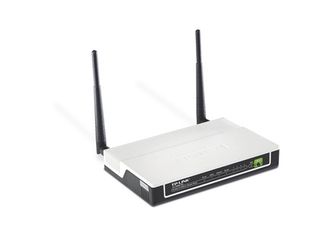Why you can trust TechRadar

Primarily the TD-W8961ND has to be a good ADSL2+ modem router, and it at least manages that in two parts.
First is a set-up wizard that tries to help configure the modem router for a long list of UK ISPs. The second is good broadband performance and, after fighting with the configuration, it matched our standard ADSL connection downstream and offered an enhanced upstream speed.
Less impressive is the wireless performance.
It uses dual antennas for two spatial streams and claims to be 300Mbps, though performance is unlikely to go beyond 130/144Mbps. To do that the router would need to use 40MHz channels, which is unlikely except in Wi-Fi free areas.
Performance even in the same room was somewhat dismal and erratic, peaking around 1.9MB/s and averaging a very poor 391KB/s.
This doesn't get any better with distance and, as we'd imagine this is the primary way people will be connecting to the modem router, it's a huge turn off for the TD-W8961ND.
Equally unattractive is the web-based interface.
In its defence it covers a lot of complex options and features, but that can't excuse a sluggish response and a bizarre half-finished look to the page design.
This does cover one positive area of the ADSL2+ modem router in that there are a number of advanced feature hiding inside, such as port binding for specific services, wireless bridge options, Annex M to double upstream rates and full QOS abilities.
It feels like a rushed product and at the time of writing the latest firmware dated 17/6/2010 lists one of its key updates as "Fix the low rate of wireless connection."
Which doesn't fill us full of confidence.
We liked:
It has a no-nonsense design that even comes with a power button. It knows it's a budget modem router and tries to play to that strength offering some ease-of-use features for novice users, but still offers a raft of more advanced options.
We disliked:
Wireless performance was something of a disaster and taints the main way you'll be using this router. It's bad enough that it could be performing worse than your broadband connection.
It doesn't help that the web-based interface has an unfriendly look, is slow to use and despite its best effort to be easy to use still baffles with a range of technical features that most will not want.

Apple sets imminent launch date for new iPads – here’s what we know

Fortnite dev reveals reason why Metroid's Samus didn't join the game, says Nintendo was 'hung up' about its characters being on other platforms

Microsoft could add yet another advert into Windows 11 - and users are running out of patience